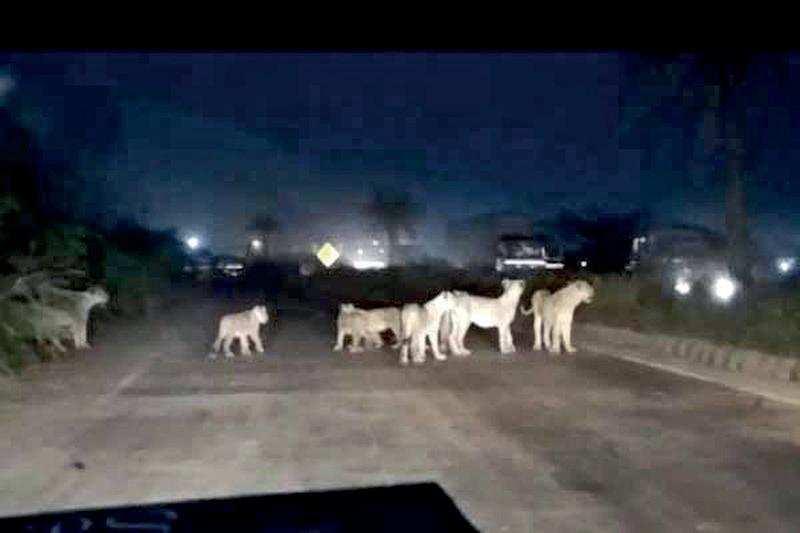
Sarubhai Rabari, brother of Bhavabhai, says, "The sloth bear attacked only for water, as borewell water was flowing on the field when the attack took place."
Foresters say the conflicts between humans and sloth bears have gone up as the animals are increasingly venturing outside the sanctuary. There have been at least four sloth bear attacks on people near the Jessore Sloth Bear Sanctuary area in last 30 days.
Not just sloth bears but even Asiatic lions and wild ass are venturing near human settlements in search of water, say farmers and villagers living near sanctuaries.
Aquatic and amphibian animals are of course the worst affected. At least 10-odd crocodile rescues have been reported from Kodinar taluka, where crocodiles from the Singhoda River are often seen venturing onto revenue land in search of water.
Some experts and villagers feel that due to inadequate rainfall in Gujarat, and especially in Banaskantha, for the last two years, the sloth sanctuary is suffering from lack of food and water, thus forcing the animals to venture out. Artificial ponds have been created inside the sanctuary as waterholes, but they seem inadequate.
Maganbhai Prajapati, former sarpanch of Balundra village, says, "As the sun sets, one can see heightened activity of sloth bears in villages near the sanctuary."
Sloth bear sightings, however, have currently gone down after villagers pressurized the administration to fill the watering holes regularly inside the sanctuary.
"Following four attacks in a month in Hariyawada, Deri and Balundra village, outcry from the villagers pressurized the administration to send one water tanker regularly to fill the waterholes. As a result, the sightings of sloth bears near human settlements have gone down," Prajapati added.
Another sarpanch, who refused to be named, said, "There have been attacks on 25-odd people in the Amirgadh taluka. The lack of water inside the sanctuary was drawing these animals out and bringing them into direct conflict with humans."
H S Singh, Member of the National Board for Wildlife, said, "In years where there is less rainfall, there is always shortage of food and water and wild animals move out of sanctuary.
Only lack of water can’t be blamed
Ganga Sharan Singh, deputy conservator of forests, Banaskantha wildlife division says, "We have adequate waterholes in the sanctuary and sloth bears venturing out of the sanctuary in search of water is a rare possibility." Singh said there are adequate waterholes in the sanctuary that are regularly filled. N P S Chauhan, the director of Institute of forest and wildlife of a private university, agrees with the view of foresters. "It may not be appropriate to say that these bears move out of the sanctuary only for water. There are several factors which may influence them," Chauhan said.
Leaving sanctuary for better food
In dry climate termites and ants decrease in the sanctuary. Moreover, in the nearby fields there are beehives, the favourite food of bears, " said G S Singh, DCF, Banaskantha. "Bears trying to rob honey may come across tribal farmers sleeping in fields at night and attacks may happen," he said. H S Singh said, "Cattle grazing in the sanctuary increases in drought years disturbing sloth bears. Moreover, mahuva flower and fruit, as also honey draws them out."
Conflict possible along natural corridors
MM Sharma, in-charge principal chief conservator of forests (wildlife) says, "There are sufficient waterholes in the sanctuaries and it is a popular myth animals move out of sanctuaries in search of food." Sharma said, "They come into conflict with humans while moving along their natural corridor." He added, "The sanctuary, in case of sloth bear is fragmented and there are fields in between these sanctuaries. Hence when an animal moves from one area to another such incidents take place." N P S Chauhan said, "There are natural corridors and sloth bears are known to explore new areas to survive."
Attacks rise after droughts
HS Singh, Member of the National Board for Wildlife, said that in case of big cats including lions, man-animal conflicts increased when after severe droughts rain arrived. After a drought in 1987-88 there were 125 attacks on humans and 20 men and women were killed. Similarly in 1901-03, when there were droughts, 64 human deaths were reported from man-animal conflicts.
Enough waterholes in lion sanctuaries
DT Vasavada, chief conservator of forests, says "In case of lions we have over 450 watering points which is sufficient. These points are filled daily and any case of lions venturing out for water is not possible." Kathi Raj, a resident of Liliya in the lion belt, says that the sightings of lions outside the sanctuary are increasing and these were mainly happening in fields where there was water. There are three to four videos daily going viral of lion groups in the fields, he said. A sarpanch of a village on the outskirts of Gir sanctuary says: "The department has adequate waterholes in the sanctuary, but lions roam across a territory that stretches till Palitana and Porbandar." He added, "In revenue areas of lion territory, there are few waterholes and lions move into agricultural fields in search of water." He added that farmers are filling field troughs with water to lure lions, as once a big cat family finds water regularly in an area, they try to settle down there.
https://timesofindia.indiatimes.com/city/ahmedabad/its-a-jungle-out-there-as-animal-attacks-rise/articleshow/69708403.cms
Himanshu Kaushik | TNN | Updated: Jun 9, 2019, ..
No comments:
Post a Comment